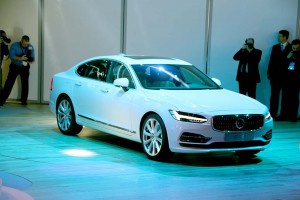
Volvo new S90 flagship is part of the maker's plans to build a portfolio of vehicles using four-cylinder engines.
There’ve been plenty of folks ready to write off Volvo since it was sold off by Ford Motor Co. to China’s Zhejiang Geely Holding Group for $1.8 billion six years ago.
But you’d be hard-pressed to find evidence of the Swedish brand’s imminent demise at this year’s North American Auto Show. Quite the contrary, Volvo launching the annual event by nabbing the sought-after honor of North American Truck/Utility of the Year for its new XC90 sport-utility vehicle.
“There couldn’t be a better way to pave the way for the new S90,” Lex Kerssemakers, Volvo’s top U.S. executive said later in the day, as the carmaker revealed the next major product in its rapidly expanding portfolio, a new flagship sedan.
Though Volvo announced details of the S90 last month, it’s getting its first public showing at Detroit’s Cobo Hall.
As with the XC90, Volvo isn’t going the me-too route. Almost as a matter of pride, it is “a bit contrarian” in its approach to future models, including the S90, said Hakan Samuelsson, CEO of Volvo Cars. Even the big sedan will pick up on the company’s new powertrain strategy – which means all four-cylinder drivetrains. Even the performance version of the new sedan will go that route with the so-called Twin Engine plug-in hybrid system, rather than the big V-8s and Twin Turbo sixes favored by luxury rivals.
(Volvo captures North American Truck/Utility of the Year. For more, Click Here.)
The Twin Engine system still makes a sporty 400 horsepower and 472 pound-feet of torque, but it offers the added advantage of permitting nearly 20 miles of driving in pure electric mode.
The new Volvo S90 and XC90 have a number of things in common, starting with the SPA, or Scalable Product Architecture, that will be used with the vast majority of future products. It’s a similar strategy to that used by a wide range of major manufacturers, including Toyota and Volkswagen, to hold down costs by boosting economies of scale.
The SPA will be used on a wide range of midsize and larger models, but Volvo has also developed a second platform, the CMA architecture, for smaller products.
Like the XC90, the new S90 will feature an array of high-tech electronics, its elegant instrument panel angered by a laptop computer-sized touchscreen display – one large enough to show off all key functions simultaneously, so motorists don’t have to go drilling down through a lot of menus to do things like change radio stations, plug in a destination or adjust the climate control.
The S90 also will get a wide range of high-tech safety features, including what Volvo promises will become the world’s first standard-equipment semi-autonomous driving system. Dubbed Driver Assist, it takes the maker’s City Safe forward collision warning system to the next level.
(Click Here for details about the 2016 Detroit Auto Show is ushering in an era of change.)
And it underscores the fact that even as it broadens its reach, Volvo isn’t abandoning its “core values,” its long-term focus on safety, Samuelsson stressed. It has, if anything, it moves closer to the goal it has dubbed “Vision 2020.” That lays out the once seemingly unimaginable target of making its next generation of products so safe that from 2020 on, “no one will be killed or seriously injured in a Volvo product.”
Safety is no longer a topic Volvo can own exclusively. Indeed, during a media roundtable at the NAIAS, Fiat Chrysler CEO Sergio Marchionne said “We need to get to the stage where safety is no longer a competitive tool,” but something all manufacturers are expected to deliver. A consortium of carmakers reportedly will announce a broad industry plan to improve safety later this week.
Still, safety will continue to dominate Volvo’s thinking, even as it expands its focus to environmentally friendly powertrain technology while also more directly competing with established luxury competitors like Mercedes-Benz and BMW.
The strategy so far seems to be paying off. Not only did Volvo begin the year by winning honors for North American Truck/Utility of the Year, but it announced setting a new global sales record for 2015, pushing past the 500,000 mark for the first time, reaching 503,127. That includes the 70,047 vehicles it sold in the U.S., a 24% increase.
(To see more about President Obama’s plans to visit NAIAS, Click Here.)
Volvo is betting that the new S90 will provide the sort of halo that will help it deliver another record for 2016.
